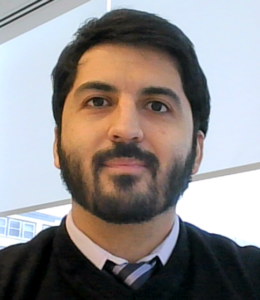On-chip Microheaters for Programmable Phase-Change Photonics
Speaker: Dr. Carlos A. Rios Ocampo - University of Maryland, College Park, MD
Date: Mar 8, 2024; Time: 2:30 PM Location: PWEB 175
 Abstract: Chalcogenide phase change materials (PCMs) have promising properties for photonic applications thanks to their nonvolatile and large refractive index modulation [1]. The last decade has seen a growing interest in such a combination of properties for a variety of nonvolatile programmable devices, such as metasurfaces, tunable filters, phase/amplitude modulators, color pixels, thermal camouflage, photonic memories/computing, plasmonics, etc.—giving rise to the so-called Phase-change Photonics field.[1] PCM-based devices rely on the precise switching between the amorphous and the crystalline states, which can be achieved through optical or electrical pulses via optical absorption and Joule heating, respectively. Optical pulse switching is the fastest and most precise method; however, it lacks scalability given the difficulty of on-chip pulse routing when considering many PCM cells. It is also limited to absorptive PCMs, such as Ge2Sb2Te5. As a scalable alternative, on-chip microheaters using multiple material platforms have been proposed, e.g. doped-silicon, graphene, ITO, metals, etc. Doped-silicon microheaters are particularly interesting since they are CMOS compatible and can be fabricated onto silicon-on-insulator (SOI) wafers—the same platform used for silicon photonic integrated circuits. However, this electro-thermal switching also has shortcomings. It lacks stable multi-level response due to the stochastic nature of both amorphization and crystallization processes in the typical bow-tie-like devices where the microheater heats the entire cell to an almost flat temperature [2,3]. Because of this, the focus is shifting towards the microheater’s geometry in addition to the choice of conductive material and its integration. One common goal is to control the hotspot size within the PCM cell to deterministically switch specific areas (i.e., spatially resolved amorphous domains in a crystalline cell) and, thus, achieve controllable and reproducible optical modulation [4,5]. In this talk, I will review the fundamentals of PCM for photonics and the proposed electro-thermal mechanisms. I will then focus on our current efforts to re-engineer doped-silicon microheaters for optimum performance.
Abstract: Chalcogenide phase change materials (PCMs) have promising properties for photonic applications thanks to their nonvolatile and large refractive index modulation [1]. The last decade has seen a growing interest in such a combination of properties for a variety of nonvolatile programmable devices, such as metasurfaces, tunable filters, phase/amplitude modulators, color pixels, thermal camouflage, photonic memories/computing, plasmonics, etc.—giving rise to the so-called Phase-change Photonics field.[1] PCM-based devices rely on the precise switching between the amorphous and the crystalline states, which can be achieved through optical or electrical pulses via optical absorption and Joule heating, respectively. Optical pulse switching is the fastest and most precise method; however, it lacks scalability given the difficulty of on-chip pulse routing when considering many PCM cells. It is also limited to absorptive PCMs, such as Ge2Sb2Te5. As a scalable alternative, on-chip microheaters using multiple material platforms have been proposed, e.g. doped-silicon, graphene, ITO, metals, etc. Doped-silicon microheaters are particularly interesting since they are CMOS compatible and can be fabricated onto silicon-on-insulator (SOI) wafers—the same platform used for silicon photonic integrated circuits. However, this electro-thermal switching also has shortcomings. It lacks stable multi-level response due to the stochastic nature of both amorphization and crystallization processes in the typical bow-tie-like devices where the microheater heats the entire cell to an almost flat temperature [2,3]. Because of this, the focus is shifting towards the microheater’s geometry in addition to the choice of conductive material and its integration. One common goal is to control the hotspot size within the PCM cell to deterministically switch specific areas (i.e., spatially resolved amorphous domains in a crystalline cell) and, thus, achieve controllable and reproducible optical modulation [4,5]. In this talk, I will review the fundamentals of PCM for photonics and the proposed electro-thermal mechanisms. I will then focus on our current efforts to re-engineer doped-silicon microheaters for optimum performance.
[1] M. Wuttig, et, al. “Phase-change materials for non-volatile photonic applications,” Nat. Photon.11(8), 465–476 (2017).
[2] J. Feldmann, et, al. “Calculating with light using a chip-scale all-optical abacus,” Nat Commun 8(1), 1256 (2017)
[3] T. Tuma, et, al. “Stochastic phase-change neurons,” Nat. Nanotechnol.11(8), 693–699 (2016).
[4] C. Ríos, et, al “Ultra-compact nonvolatile phase shifter based on electrically reprogrammable transparent phase change materials,” PhotoniX 3(1), 26 (2022).
[5] X. Li, et, al, “Fast and reliable storage using a 5 bit, nonvolatile photonic memory cell,” Optica 6, 1-6 (2019)
[6] Y. Zhang, et, al, “Myths and truths about optical phase change materials: A perspective.” Appl. Phys. Lett. 118 (21): 210501.
Biographical Sketch: Carlos A. Ríos Ocampo is an Assistant Professor at the University of Maryland, College Park, where he has led the Photonic Materials & Devices groups since 2021. Before joining UMD, Carlos was a Postdoctoral Associate at MIT, received a DPhil (PhD) degree in 2017 from the University of Oxford (UK), an MSc degree in Optics and Photonics in 2013 from the KIT (Germany), and a BSc in Physics in 2010 from the University of Antioquia (Colombia). Carlos’s scientific interests focus on studying and developing new on-chip technologies driven by the synergy between nanomaterials and photonics.